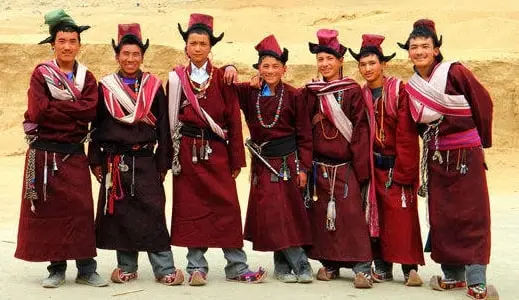Traditional dress plays a vital role in the cultural identity of any region. Traditional Ladakhi dress has been found to protect people from the harsh cold weather in Ladakh. Pashmina and wool are used to build high-quality hats, shawls, thermals, and socks. Here is a list of the traditional dress worn by men and women in Ladakh.
Ladakh Traditional Dress of Men

1. Goncha
Goncha, commonly referred to as Kos, is a voluminous gown worn by Men in Ladakh. The fabrics used are velvet, cotton, wool, polyester, or a combination. The regular Goncha used daily is burgundy, black, grey, or brown color. Wedding gonchas are of vibrant color. It is made of velvet, silk, brocade, or wool. These are imported from countries like Bhutan and Nepal. While youngers prefer lightweightGoncha, elders still have a choice for heavy wool to protect themselves from heat.
2. Tipi
Tipi or tibi is a Ladakhi hat worn by men. Tipi is a headgear made from brocade. It sits freely on the head and covers a part of the hair. Buddhist community members in Ladakh prefer wearing colorful hats during weddings and special events. Men prefer wearing monochrome or maroon tipi.
3. Traditional Brokpa Costume for Men
Brokpa is a distinct tribal community in Ladakh. They have their own religion, social rules, customs, and traditions. Men wear a white woolen outfit paired with a matching waistcoat and woolen pants.
Ladakh Traditional Dress for Women in Ladakh
1. Yogar and Lokpa
Yogars are traditional cloaks worn by women to cover their backs. They are made of sheepskin. The inner side is made of wool, protecting the wearer from extreme cold weather. The yogar is prepared from green fabric with silk brocade and red patterns. In earlier times, the yogar was a basic necessity for women in Ladakh, but today, it is used only during festivals and special events.
2. Kos Kar
Changpa Nomads in Ladakh wear a special kind of clothing: a white robe known as Kos Kar or Lawa Goncha. These are extremely warm and rugged clothing made of sheep wool and skin.
3. Traditional Brokpa Costume for Women
Brokpa tribe females prefer wearing pale garments with the lokpa covering their backs. This traditional attire is designed with silver, stones, shells, and other precious jewels.
Traditional Head gears for women in Ladakh
1. Jugin
The Muslim communities of Ladkh wear jugins. This ornament contains a block of gold hanging from the forehead with a bunch of pearls. This attire is followed by a see-through drape with embroidery that covers the women’s heads and faces.
2. Gha-ram and Ser-po Tibi
The Zanskar tribal community of Ladakh wears the same attire as all other Ladakh people. What distinguishes them is their peculiar cap. Gha-ram Tibi are warm caps made of coarse material of yellowish hue. They have Kashmiri origin. The Ser-po-Tibi are made of Nambu, a felt-made wool of Ladakh.
3. Perak
Perak is a wealthy hereditary possession of the Ladakh Women. It is a massive and heavy blue headdress that runs from the wearer’s forehead towards the lower back. The stunning blue turquoise stone ornament is embedded on a padded base of the headgear, while silver charms and coral trinkets decorate the edges.
4. Montho Tibi (Brokpa Headdress)
Dard people wear this Brokpa headgear made of a floral bouquet. This saffron-colored bulbous flower is known as Shoklo or Montho. The headgear is adorned with coins, peacock feathers, and beautiful metal trinkets.
Ladakh Traditional jewellery and footwear
1. Kau or Gau
Gau is an octagonal and hexagonal golden amulet the size of a fist. It is embedded with precious stones and pearls in fine, intricate designs.
2. Pabu, Khulu and Lapul
Pabu are traditional shoes made of yak or goat leather. Thikma-designed stripes on the sides of the shoes are known as Thikma Pabu. Khulu and Lapul are simple shoes used for regular wear.
Conclusion
Ladakhi clothing is a fascinating blend of practicality and cultural expression. Even with modern influence, Ladakhi people continue to cherish their unique sartorial heritage, with many traditional elements still worn during festivals and special occasions. As visitors, we must appreciate these traditional garments, which offer a strong understanding of the region’s culture and people.

